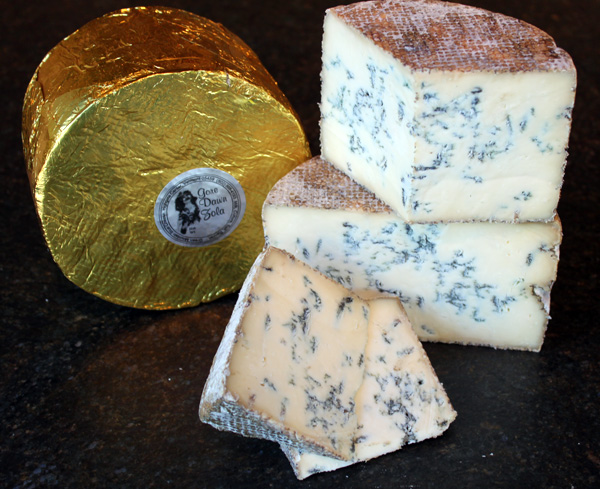Back to Basics: What Makes Blue Cheese Blue?

Blue cheese. You know, that kind of cheese that looks like it’s moldy and has maybe gone “off” or “bad” but is actually perfectly fine and in fact is supposed to look that way? Adored by some and loathed by probably more, blue cheeses are a category unto themselves and in this installment of Back to Basics, we thought we’d discuss what makes a blue cheese, well, blue.
Blue cheeses begin their lives like almost all cheeses, starting off as milk, possibly being pasteurized, getting added to a vat along with cultures and rennet, heated up, cut into curds and molded, etc. (For a more thorough discussion of how cheese is made, please feel free to look back at our first post in this series!) The one key difference is that along the way, specific molds (typically one of the hundreds of varieties of Penicillium roqueforti, hereafter referred to as P. roqueforti) are encouraged to grow in the cheese, usually by being directly introduced to the curds and then being exposed to the air later on during affinage. When there are enough of these mold colonies growing, they appear as visible ribbons or speckles of green & blue and voilá: you have blue cheese!
Many blue cheeses have the mold added to the curds during the molding (happy coincidence there) portion of the make, when they’re being ladled or scooped into hoops, baskets, etc. When aging, the wheels are pierced using long, slender needles, creating holes and pathways for air to both enter and leave. And just to get a little specific, it’s the oxygen in the air that’s needed to help the molds grow; P. roqueforti thrives in damp, cool, aerated environments (like the French caves from whence it comes) and piercing or “needling” the wheels of cheese in their humid aging caves mimics this kind of environment. And there you have it: mix some mold into your curds, and some air, and you have blue cheese!
But before you run off and start your own blue cheese operation (and we know you want to), remember that this is just an overview of the basic way many blue cheeses are made. Exceptions always exist, like the British powerhouse Stilton which cannot be inoculated with the mold at any time; all the P. roqueforti comes straight from the milk and air. On the other hand, there’s the French sheep’s milk classic Roquefort (named, along with this handy mold we’ve been discussing, after its origin in the town of Roquefort), which traditionally gets its mold from moldy rye bread crumbs being added to the curds. And then again, some cheeses don’t use P. roqueforti at all but instead use P. glaucaum/expansum, such as the Italian dynamo Gorgonzola.
And while all blue cheeses are made with basically the same process, they certainly don’t all look or taste the same! You know how some blues look like marble and some look they have blue freckles? Those different appearances result from either the curds being milled- which results in blue ribbons and striations, like Stilton- or from yeast being added to the milk along with the cultures, which results in little pockets or speckles of blue, like Maytag. As for the flavors, each recipe is unique, calling for different cultures, different milk, different amounts of salt, etc. So, while they may all have that strong piquancy associated with the blue mold- often referred to as ‘stinky’, though this descriptor is used for a different classification of cheese in the cheese world- they remain individuals. And trust us, they are all worth a try!



